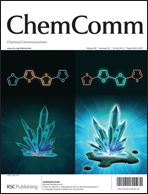Reduced impurity-driven defect states in anodized nanoporous Nb2O5: the possibility of improving performance of photoanodes†
Abstract
Anodized nanoporous Nb2O5 films are synthesized using two different types of electrolyte compositions onto transparent conductive glasses and their impurities induced during the anodization process are assessed. These films are incorporated as photoanodes in


 Please wait while we load your content...
Please wait while we load your content...